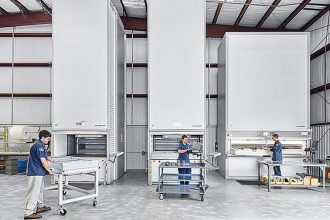Cloud Vs. On-Prem WCS

Considering the pros and cons of each for an optimal solution.
Many warehouses these days are full of automation, and for good reason. By placing automated equipment and systems on your floor, you’re better able to respond to market conditions. You can also help mitigate the issues associated with the labor shortage, which isn’t going away any time soon. Labor costs are high, as is turnover. Companies looking for gains in productivity, coupled with customer expectations for in-stock items help drive the need for automation. From robotics to automated storage, conveyors, print and apply systems and everything in between, automation is essential to efficient operations.
Behind most automation is software known as WCS (warehouse control systems). These packages sit between an ERP or WMS and the automation you’ve implemented on a floor. Its job is to drive the equipment with real-time execution—this ensures quick, rapid decisions from the automation. It is connected to programmable logic controllers (PLCs) for the equipment throughout the facility. PLCs translate software instructions to electrical outputs so that automation can execute its instructions. Many original equipment manufacturers provide the WCS to drive the equipment for enhanced functionality.
WCS contains instruction sets and detailed information driven by process data. For instance, when considering an automated storage system, WCS software might contain the specific location of an item. In contrast, an ERP or WMS only knows that the item is within the ASRS, not its exact location. When the item is needed for picking, the WCS requests the PLC to execute the electrical controller instructions necessary to retrieve and deliver a certain storage tray or tote to the picker.
Historically, WCS has been available in an on-premise format. This makes sense because it is needed for quick decision making and interfaces with multiple forms of automation equipment. Its response times are critical for real-time decision making. For instance, if a parcel hits a print and label apply station on a high-speed conveyor, you want to avoid lag time so that you don’t create a bottleneck.
When considering an off-prem, or cloud-based WCS, there are several factors to keep in mind. The benefits of this option include fewer up-front costs, in some cases; it can work as an SaaS model; it provides upgrades and maintenance, something you must manage on your own with an on-prem solution.
WCS systems often need to process data and respond in real-time, especially in automated warehouses with robotic systems. On-premises systems can offer lower latency compared to cloud-based systems, which is crucial for time-sensitive operations.
You can successfully combine a WCS with a WMS package in a way that allows for a hybrid on-prem/off-prem system. You’ll get a comprehensive system to manage the warehouse, WCS functionality on-prem, with WMS functionality off-prem. This sometimes delivers the best of both worlds. With a variety of options to consider, you can find the right solutions for your specific operations.
For more information about the Solutions Community: mhi.org/solutions-community
For further articles from the Solutions Community:
Digitization of Intralogistics—Replenishment
Digitization Of Intralogistics: Labor
Digital Twin for Intralogistics
The Digitization of Intralogistics: Returns
Past vs. Future: The Difference Between On-Premise and Cloud-Based WMS
Sophisticated Condition Monitoring



